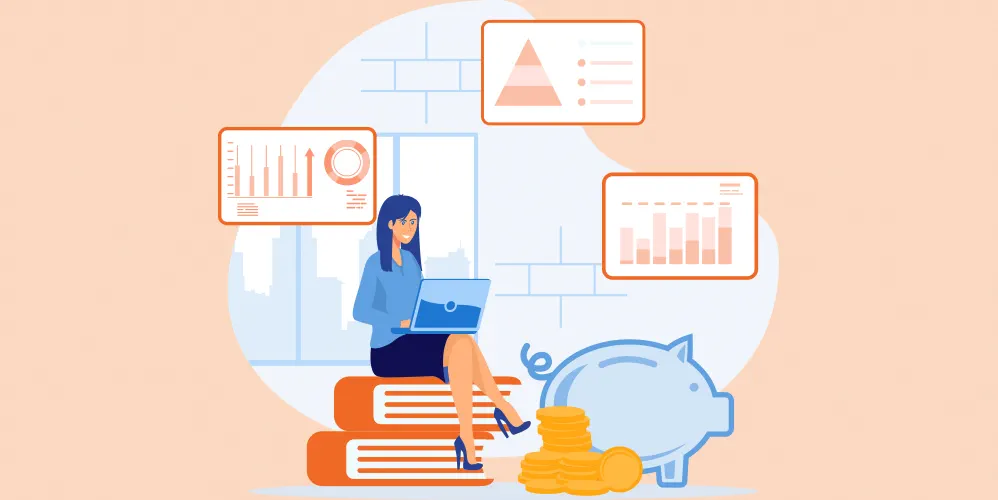
Kids Bank Accounts - Features and Benefits
03 जुलाई 2019

Table of Content
Introduction
With advancements in banking technology, there are different types of savings accounts that are available to the people. One such type of savings account is a kids bank account. A Kids Bank Account is an account that can be operated by a child below 18 years. The child can thus imbibe a financial savings habit from early on.
Features of a Kids Bank Account
- This bank account can be opened for children below 18 years. For children below 10 years, the account can be opened but can’t be operated by the child unless it is jointly operated by the parent or legal guardian. Once the child crosses 10 years, he can manage the account.
- The kids bank account becomes inoperative after the child becomes a major. However, banks give the accountholder an option to convert their kids bank account into a regular savings account.
- The child gets some of the features provided in a regular Savings Account such as cheque book, pass book and ATM card. However, these come with restrictions.
- The kids bank account is linked to the parent or the legal guardian’s account. Each month or at a fixed interval, a sum of money is debited from the linked account to the kids bank account. This way, there is always balance in case the child spends money on the debit card. This linking feature is not available in all Banks.
- Each bank has its own limits on the ATM withdrawal allowed and the per day spend allowed in a kids bank account. These safeguards prevent misuse of this account and the possibility that the child will spend more money than a particular limit.
- The bank may provide a login Id and a password so that the child can operate internet banking. However, the bank usually gets a signed mandate from the parent or legal guardian before it issues the login ID and password.
- These accounts must have a certain minimum account balance. The minimum account balance differs from bank to bank. In case the minimum bank account is not met, the bank charges a penalty.
- The bank sends an SMS to the parent or legal guardian every time a transaction is performed in relation to the kids bank account. This helps maintain control.
Benefits of Kids Bank Account
- A kids bank account is an excellent way to teach your child fiscal responsibility. Through this bank account, your child can learn how to operate a bank account , especially when the funds are limited.
- This account teaches a child the value of budgeting since there is a limit on the transactions that can be done every day. There is also a limit on the funds in the account and a minimum account balance that has to be maintained.
- Some Banks provide free insurance for the child on opening the kids bank account
- Banks may have auto sweep in facility that converts excess balance into a fixed deposit so that the earnings on the account are maximized.
How to Open a Savings Account for Kids
The procedure on how to open a kids bank account is extremely simple. The first step is to find out which bank to open the account with. It is better to open a savings account in a bank in which the parents or the legal guardian have an account. This helps the bank to link the two accounts and to put in a standing instruction to auto debit the parents or guardian’s account for funds (if linking facility is available).
Once the bank is decided, the account can be opened by filling up an account opening form on the bank’s website. Once this form is filled up, someone from the customer care department of the bank will contact you to get documents from you. Some of the documents required are:
- KYC documents for parent or legal guardian
- KYC documents for child
- Passport size photographs of the child
- Duly completed application form
In case an online application procedure is not possible, you can visit a branch, fill the form and submit the documents to open a new account.
Kids Bank Account Tax Implications
As per the Income Tax Act, 1961, a child’s income from investments made in his name by parents is clubbed with the parent’s income. Unless the income is from the child’s own skills, in which case it is taxed in the child’s name.
Whatever interest is earned on the savings account balance or the fixed deposit through sweep in, will be clubbed with the parent or the legal guardian’s income. This income is clubbed with the working parent’s income. In case both the parents are working, this income is clubbed with the parent whose income is higher.
However, the Income Tax Act also exempts Rs. 1,500 per child for clubbed income. This provides a little bit of relief from taxation. It is important to consider children’s bank account tax as well before opening the account. However, the benefits of opening an account and teaching your child financial lessons trumps the amount paid in terms of tax on savings bank account interest.
Popular Articles
Related Articles









What Is Joint Account? - Meaning, Benefits, Application Process & How its Work

-
डिस्क्लेमर
इस लेख/इन्फोग्राफिक/चित्र/वीडियो की सामग्री का उद्देश्य केवल सूचना से है और जरूरी नहीं कि यह बैंक ऑफ बड़ौदा के विचारों को प्रतिबिंबित करे। सामग्री प्रकृति में सामान्य हैं और यह केवल सूचना मात्र है। यह आपकी विशेष परिस्थितियों में विशिष्ट सलाह का विकल्प नहीं होगा । बैंक ऑफ बड़ौदा और/या इसके सहयोगी और इसकी सहायक कंपनियां सटीकता के संबंध में कोई प्रतिनिधित्व नहीं करती हैं; यहां निहित या अन्यथा प्रदान की गई किसी भी जानकारी की पूर्णता या विश्वसनीयता और इसके द्वारा उसी के संबंध में किसी भी दायित्व को अस्वीकार करें। जानकारी अद्यतन, पूर्णता, संशोधन, सत्यापन और संशोधन के अधीन है और यह भौतिक रूप से बदल सकती है। इसकी सूचना किसी भी क्षेत्राधिकार में किसी भी व्यक्ति द्वारा वितरण या उपयोग के लिए अभिप्रेत नहीं है, जहां ऐसा वितरण या उपयोग कानून या विनियमन के विपरीत होगा या बैंक ऑफ बड़ौदा या उसके सहयोगियों को किसी भी लाइसेंसिंग या पंजीकरण आवश्यकताओं के अधीन करेगा । उल्लिखित सामग्री और सूचना के आधार पर किसी भी वित्तीय निर्णय लेने के लिए पाठक द्वारा किए गए किसी भी प्रत्यक्ष/अप्रत्यक्ष नुकसान या देयता के लिए बैंक ऑफ बड़ौदा जिम्मेदार नहीं होगा । कोई भी वित्तीय निर्णय लेने से पहले अपने वित्तीय सलाहकार से सलाह जरूर लें।
Baroda Premium Current Account-Privilege (BPCAP)
The Baroda Premium Current Account-Privilege is an ideal account for customers who own medium to large businesses. Account holders can avail several free services and benefits under the BPCAP account. The privilege current account is designed to meet several specific needs of customers holding the account. Immediate credit of outstation cheques and auto payroll are some of the key benefits offered with this account.
Key features of the Baroda Premium Current Account-Privilege
Free cheque books
BCAP account holders can obtain free unlimited chequebooks for their transactions.
Account statements
Account holders can get free account statements, twice a month.
Free facilities
BCAP account holders get free banker’s cheques, balance certificates, MT/TT facilities and signature verification facilities. They also get free auto payroll, internet banking facility, SMS alert and missed call facilities. Folio charges on the account are also waived off.
Fund transfer
No charges are levied for funds transferred at BOB’s Core Banking Solution branches.
Auto and reverse sweep facility
Account holders can deduct a minimum amount of ₹25,000 through the auto-sweep facility, provided their balance has crossed ₹5.25 lakh. Reverse sweep facility is also available.
Free Cash withdrawals
Free unlimited cash withdrawals at home branches however up-to ₹50,000 are permitted per day at non-home branches only for withdrawals made through self-cheques
Benefits of the Baroda Premium Current Account-Privilege
Account holders get a debit card (for Individual & Sole Proprietorship accounts only) with annual charges waived off for the first year
Outstation cheques of up-to ₹1.5 lakh are credited immediately credited for customers holding the account for a period of 6 months and above
Account holders are provided with a free credit card with annual charges for first year, waived off
Account holders receive a complimentary personal accident insurance cover with the credit card
Loan processing fees are waived off for car loans disbursed in the name of the firm or proprietor
20% discount is offered on BOB locker rental charges
Free standing instruction against account service if offered with the account
Nomination facility is offered with the account
Saving accounts features
What are the features of a savings account?
A savings account is the first step a person takes toward saving. As the name suggests it is a place where the savings are stored but it is not an investment.
The savings account is the conduit through which investments can be made. But the first step starts from taking the money out of your money box and into a bank.
Why have a savings account?
Rather than keeping money at home in your money box, keeping it in a bank is suitable as it offers interest on the deposit made. This is the main reason why you have a savings account. The interest rate is not high, but it helps in partially softening the blow of inflation. In other words, the money one deposits in the bank are working to give you some return. Not only is the money in the savings account safe and earns interest it has other advantages also.
Features of a savings account
The following are the features of savings account
First, the money can be withdrawn at any point in time. With ‘Any-Time-Money’ (ATM) counters available across the country, a saving bank account holder who has debit/ ATM card facility can withdraw money from anywhere in the country. This adds a safety element where the depositor need not move around carrying cash in his pocket.
With e-payment on the increase, the saving bank account helps in regular monthly payments like that of electricity, society maintenance, telephone and mobile bill payment, insurance premium payment among others.
Salaries can be directly credited to the savings bank account. This helps both the employee as well as the employer. For the employer with a single click of the button, money is transferred to all the employees. For the employee, they are saved the travel to the bank as well as can have the money credited in their account at a faster pace.
Post-retirement the same savings bank account helps in getting a regular pension.
Loans that a person takes are generally linked to the savings bank account which is the primary account where his salary is deposited. Direct electronic instructions can be given from the savings bank account or Post Dated Cheques (PDCs) from this account. Savings bank account often eases the process of availing loans.
Cheque bounce history of the customer’s savings account tells his creditworthiness. A customer with no defaults on loans on his name has a much higher credit rating and finds it easier to get loans.
Having a savings bank account encourages the habit of saving rather than keeping cash in hand. This discourages impulsive shopping.
Savings account helps in accessing other financial instruments like online trading, mutual funds investments through direct transfers among others.
A standing instruction can be given to the bank where if the amount in the Savings Account crosses a particular threshold it will be transferred to any other higher yielding instrument.
It helps in making travel plans easier by booking tickets as well as hotel bookings through online mode.
The passbook or electronic statement of the savings bank helps in keeping an automatic tab of where the money came from and where it was spent.
At the end of the year, it helps in filling your tax returns with the income tax authorities. Since all the transactions are recorded in the bank statement, a salaried employee has the little hassle to file his returns.

